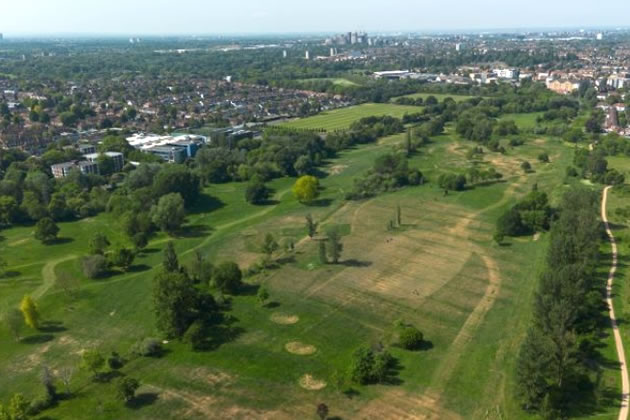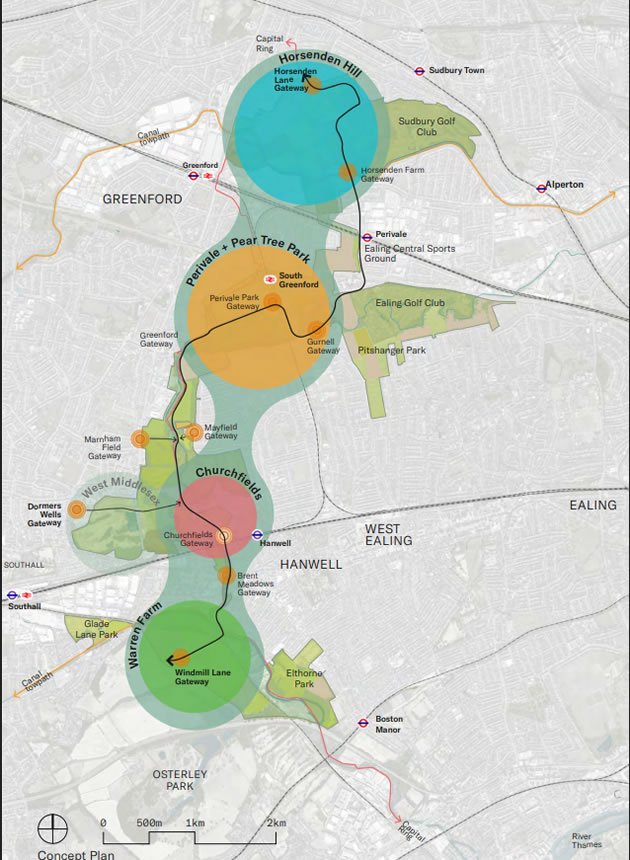Update Reveals Progress on Regional Park Plan
Ambition shifts towards expansion into other boroughs

The vision is for 8 kilometres of linked green spaces. Picture: Ealing Council
May 22, 2025
A report on progress being made with Ealing Council’s plans for a regional park has been presented to the council’s cabinet.
Councillors were informed that architects Prior + Partners has complected a detailed concept plan which proposes a network of focal areas including Warren Farm, Perivale Park, Horsenden Hill, Churchfields), each offering unique ecological, recreational, and cultural features.
The main new information revealed was that planning has begun to move towards a “West London Regional Park” with discussions with Hounslow and the National Trust underway to expand the park beyond Ealing’s boundaries into contiguous green space north and south of the borough.
There were also more details on the proposed Regional Park Trail which will cover a distance of 8km and link key destinations across the park, will be designed for walking, cycling, and be accessible.
A comprehensive Health Impact Assessment was completed in March to evaluate health and equity outcomes. Its findings emphasised the need for accessible transport and signage, safety features (lighting, CCTV, staff presence), dog management zones and co-development with community groups
A bid has now been submitted to the Nature, Towns and Cities Fund and, if successful, funding will support the development of a business Plan, a Green Infrastructure Strategy, a Local Nature Recovery Plan as well as trail designs, engagement, branding, and staffing. Match funding of £50,000 over 3 years is required.
A phased development approach is being adopted for the project with the focus in the first five year on wayfinding, tree planting, ecological improvements. Beyond that there will be the development of visitor centres, wetlands, sport facilities with the long-term ambitions for the scheme including land acquisition and cross-borough partnerships.

The focal points for the regional park plan. Picture: Prior and Partners
There were 6,000 responses to the consultation on the proposal earlier this year with 76% showing support for the park. 82% of respondents said in the recent consultation that supporting nature was either important or moderately important to them. The key themes stressed by respondents included biodiversity, access, air quality, health along with demands for cafés, sport spaces and cultural events. Support is strongest among 25–34 year-olds and in Northolt but there was a more mixed response from people living in Perivale.
Council leader Peter Mason said, “Everyone in our borough deserves space to experience the joys of nature, wildlife and the great outdoors. Not everyone in our borough has the benefit of their own private outdoor space, so we are creating a garden for Ealing in the shape of our new regional park.
“This is part of our commitment to re-grow and re-wild our borough, delivering 10 new parks and planting 50,000 more trees to help combat the climate crisis; at the same time as ensuring even more people have spaces to connect and play, meet friends, neighbours and family and enjoy sports, performances and culture.
“There has been so much enthusiasm and support for developing new ideas to make Ealing’s parks and open spaces even greater than they are now, and these proposals take us the next step to making it happen.”
Councillor Blerina Hashani, the council’s cabinet member for thriving communities, added, “The focus of work until now has been on the creation of a regional park spreading right across our borough, but contained within our boundaries. However, in recent months, we’ve been talking with neighbouring councils and organisations to discuss the potential to extend the regional park into areas beyond our borough to create a larger regional park for west London.
“The majority of feedback on the proposals has been incredibly positive. It is an exciting prospect. And an even bigger regional park than we originally pictured would attract even more people to west London and could mean even more amazing opportunities to boost local sport and culture.
“It would also provide wider-ranging opportunities to tackle climate change through rewilding and conserving green spaces and natural habitats, planting more trees and supporting wildlife. It is a plan for our area’s long-term future, as well as for the shorter-term enjoyment of the open spaces on our doorstep.”
Like Reading Articles Like This? Help Us Produce More This site remains committed to providing local community news and public interest journalism. Articles such as the one above are integral to what we do. We aim to feature as much as possible on local societies, charities based in the area, fundraising efforts by residents, community-based initiatives and even helping people find missing pets. We've always done that and won't be changing, in fact we'd like to do more. However, the readership that these stories generates is often below that needed to cover the cost of producing them. Our financial resources are limited and the local media environment is intensely competitive so there is a constraint on what we can do. We are therefore asking our readers to consider offering financial support to these efforts. Any money given will help support community and public interest news and the expansion of our coverage in this area. A suggested monthly payment is £8 but we would be grateful for any amount for instance if you think this site offers the equivalent value of a subscription to a daily printed newspaper you may wish to consider £20 per month. If neither of these amounts is suitable for you then contact info@neighbournet.com and we can set up an alternative. All payments are made through a secure web site. One-off donations are also appreciated. Choose The Amount You Wish To Contribute. If you do support us in this way we'd be interested to hear what kind of articles you would like to see more of on the site – send your suggestions to the editor. For businesses we offer the chance to be a corporate sponsor of community content on the site. For £30 plus VAT per month you will be the designated sponsor of at least one article a month with your logo appearing if supplied. If there is a specific community group or initiative you'd like to support we can make sure your sponsorship is featured on related content for a one off payment of £50 plus VAT. All payments are made through a secure web site. |